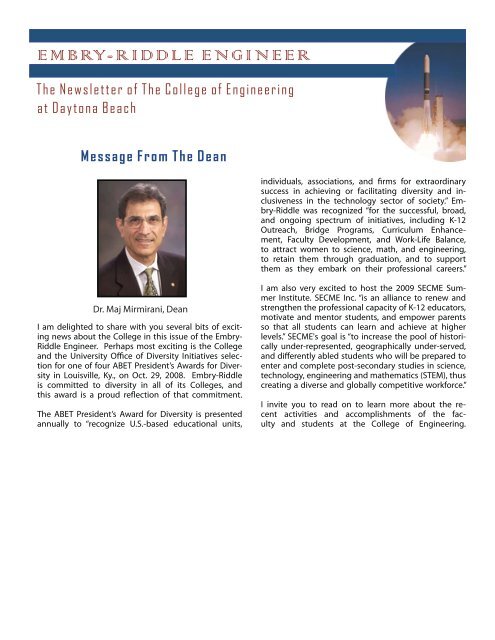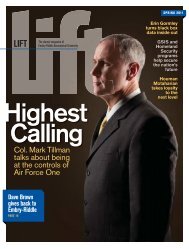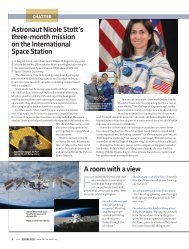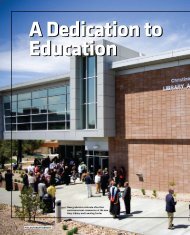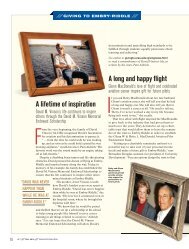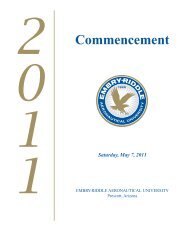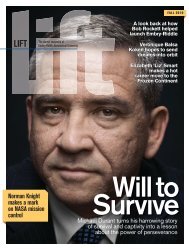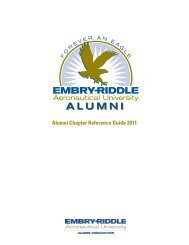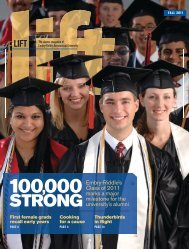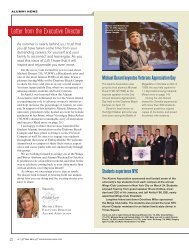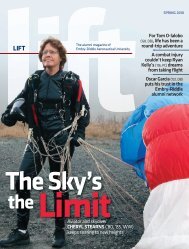embry-riddle engineer - Embry-Riddle Aeronautical University Alumni
embry-riddle engineer - Embry-Riddle Aeronautical University Alumni
embry-riddle engineer - Embry-Riddle Aeronautical University Alumni
Create successful ePaper yourself
Turn your PDF publications into a flip-book with our unique Google optimized e-Paper software.
E MBRY-RIDDLE ENGINEERT h e N e w s l e t t e r o f T h e C o l l e g e o f E n g i n e e r i n ga t D a y t o n a B e a c hM e s s a g e F r o m T h e D e a nindividuals, associations, and firms for extraordinarysuccess in achieving or facilitating diversity and inclusivenessin the technology sector of society.” <strong>Embry</strong>-<strong>Riddle</strong>was recognized “for the successful, broad,and ongoing spectrum of initiatives, including K-12Outreach, Bridge Programs, Curriculum Enhancement,Faculty Development, and Work-Life Balance,to attract women to science, math, and <strong>engineer</strong>ing,to retain them through graduation, and to supportthem as they embark on their professional careers.”Dr. Maj Mirmirani, DeanI am delighted to share with you several bits of excitingnews about the College in this issue of the <strong>Embry</strong>-<strong>Riddle</strong> Engineer. Perhaps most exciting is the Collegeand the <strong>University</strong> Office of Diversity Initiatives selectionfor one of four ABET President’s Awards for Diversityin Louisville, Ky., on Oct. 29, 2008. <strong>Embry</strong>-<strong>Riddle</strong>is committed to diversity in all of its Colleges, andthis award is a proud reflection of that commitment.The ABET President’s Award for Diversity is presentedannually to “recognize U.S.-based educational units,I am also very excited to host the 2009 SECME SummerInstitute. SECME Inc. “is an alliance to renew andstrengthen the professional capacity of K-12 educators,motivate and mentor students, and empower parentsso that all students can learn and achieve at higherlevels.” SECME's goal is “to increase the pool of historicallyunder-represented, geographically under-served,and differently abled students who will be prepared toenter and complete post-secondary studies in science,technology, <strong>engineer</strong>ing and mathematics (STEM), thuscreating a diverse and globally competitive workforce.”I invite you to read on to learn more about the recentactivities and accomplishments of the facultyand students at the College of Engineering.
E NGINEERING NEWS<strong>Embry</strong>-<strong>Riddle</strong> Keeps Top Spot In U.S. News & World Report’sBest College Rankings For Ninth Year In A RowFor the ninth year in a row, <strong>Embry</strong>-<strong>Riddle</strong> <strong>Aeronautical</strong><strong>University</strong> has earned the top ranking inthe annual “America’s Best Colleges” guide publishedby U.S. News & World Report magazine.Florida, Georgia, Kentucky,Louisiana, Mississippi,North Carolina, SouthCarolina, Tennessee, Virginia,and West Virginia.In related news, <strong>Embry</strong>-<strong>Riddle</strong> also announcedplans to offer two Ph.D.programs in 2009, pendingaccreditation by theCommission on Collegesof the Southern Association of Colleges and Schools.Dr. John Johnson, PresidentIn the specialty category of “Best Aerospace/<strong>Aeronautical</strong>/AstronauticalEngineering Programs at SchoolsWhose Highest Degree is a Bachelor’s or Master’s,” <strong>Embry</strong>-<strong>Riddle</strong>’sDaytona Beach campus has been numberone every year since the category was introduced in2001. <strong>Embry</strong>-<strong>Riddle</strong>’s Prescott, Ariz., campus has beennumber three in that category since 2004. The U.S. AirForce Academy took second place this year, the U.S.Naval Academy fourth, and Cal Poly – San Luis Obispofifth.<strong>Embry</strong>-<strong>Riddle</strong> has one of the largest and mostwell-regarded Aerospace Engineering programsin the nation. The Daytona Beach and Prescottcampuses offer a B.S. in Aerospace Engineering.The Daytona Beach campus also offers two differentmaster’s programs in Aerospace Engineering.“For the ninth straight year, U.S. News has honored<strong>Embry</strong>-<strong>Riddle</strong> for outstanding achievement,” said Dr.John P. Johnson, <strong>Embry</strong>-<strong>Riddle</strong> president. “This prestigiousaccomplishment was made possible by topcaliberfaculty, staff, and students in our <strong>engineer</strong>ingdepartments and throughout the <strong>University</strong>.”The <strong>University</strong> will offer the first Ph.D. in Aviationin the United States through the combined effortsof the Colleges of Aviation at Daytona Beachand Prescott and the Worldwide Campus beginningin May. The Ph.D. in Aviation is primarily an onlineprogram with one-week residencies each year.An August debut is planned for a traditional Ph.D. programin Engineering Physics at the Daytona Beachcampus, with special emphasis on space physics, upperatmospheric physics, remote sensing, spacecraftinstrumentation, spacecraft systems <strong>engineer</strong>ing, andcontrol of aerospace systems. Faculty research in theseareas is one of the major strengths of the <strong>University</strong>.“These doctoral programsare designed to give bothworking professionals andresearch professionals theopportunity to pursuetheir intellectual intereststhrough rigorous programsand meet their professionalgoals to prepare themto serve as our aviation,science, and <strong>engineer</strong>ingtechnology leaders of tomorrow,”said Dr. Johnson.<strong>Embry</strong>-<strong>Riddle</strong>’s Daytona Beach campus is 12th in theoverall category of “Best Universities – Master’s (South),”up one spot from last year. This category lists 121 master’sdegree-granting institutions in Alabama, Arkansas,2
E NGINEERING NEWSFlorida Center For Advanced Aero-Propulsion<strong>Embry</strong>-<strong>Riddle</strong>, the leader in aerospace and aviationeducation, is part of a consortium of four universities- Florida State <strong>University</strong>, <strong>University</strong> of Central Florida,and <strong>University</strong> of Florida - that was awarded a threeyear$14.5 million grant in July to establish the FloridaCenter for Advanced Aero-Propulsion (FCAAP). TheCenter is led by Florida State <strong>University</strong> with the localunits in the three universities as branches of the mainCenter at FSU. These universities will work collaborativelyto develop innovative next-generation technologiesfor aerospace and aviation commercial use andbuild closer working relationships with industry leaders.This funding was in response to a proposal written byfour investigators, one from each of the partner Universities.Dr. Reda (Ray) Mankbadi is the principal investigatorfrom ERAU. Dr. Mankbadi is a distinguished professorof aerospace <strong>engineer</strong>ing at <strong>Embry</strong>-<strong>Riddle</strong>’s Collegeof Engineering, and serves as the Associate Director forFCAAP.“This program is an exciting and excellent opportunityto enable <strong>Embry</strong>-<strong>Riddle</strong>’s faculty and Ph.D.candidates to demonstrate our expertise in aerospace<strong>engineer</strong>ing,” said Dr. Christina Frederick-Recascino,vice president for research at <strong>Embry</strong>-<strong>Riddle</strong>.As one of the four key higher education institutions thatassisted in making FCAAP a reality, <strong>Embry</strong>-<strong>Riddle</strong>’s participationin the program will concentrate on three specificareas of advanced research lead by Dr. Mankbadi:• Flow control mechanisms, turbulence control, andnoise generation in jet engines to improve fuel efficiencyand operational performance under various conditions.Dr. Reda Mankbadi• Advanced turbine and alternative power technology–developingthe next generation of engines that userenewable energy sources, such as hydrogen. <strong>Embry</strong>-<strong>Riddle</strong> researchers also will be studying new coolingtechnologies that will enable turbine engines to run athigher temperatures to provide more thrust and engineefficiencies.Dr. Sathya Gangadharan is a Professor of MechanicalEngineering at <strong>Embry</strong>-<strong>Riddle</strong>. He has been teachingand conducting research at ERAU since 1990. He is a LicensedProfessional Engineer (P.E.) in the State of Floridaand a Certified Manufacturing Engineer (C.Mfg.E.).Faculty Profile• Developing analytical tools for the next generation ofmicro-air vehicles and hypersonic vehicle technologies,as well as other future high-speed aircraft transport.His areas of interest include Parameter Estimation;Modeling and Design Optimization; Structures andStructural Dynamics; Fluid-Structure Interaction; andManufacturing. He is currently working on NASAfunded spacecraft fuel slosh research and FSGC fundedresearch on vibration control of spacecraft boomstructures. He has also advised several NASA MicrogravityStudent projects. He was a Summer FacultyFellow at NASA Kennedy Space Center for three years.Dr. Gangadharan is an Associate Fellow of AmericanInstitute of Aeronautics and Astronautics (AIAA);Chair, AIAA National Design Committee of SAC;Dr. Sathya GangadharanSenior Member, Soc. of Naval Arch. and Marine Engineers(SNAME); and Member, Society of ManufacturingEngineers (SME). He has worked on many fundeddesign and research projects. He is a National Evaluatorfor Manufacturing Education Resource Center(MERC) and a reviewer for ASEE and AIAA journals.3
E NGINEERING NEWSERAU Students Perform Experiment In NASA Zero Gravity Flight ProgramNASA has been selecting undergraduate student teamsfrom ERAU to experiment in a microgravity environment,25,000 feet above the Earth. Dr. Sathya Gangadharan ofthe Mechanical Engineering Department advises <strong>engineer</strong>ingteams for the annual NASA Reduced GravityStudent Flight Opportunities Program (RGSFOP).The RGSFOP allows students the opportunity to fly anexperiment of their own choosing in a microgravity environmentto test for empirical data on a level unseenon the ground. Students must design, fabricate, and executea project with NASA and be among a select fewchosen out of a substantial pool of teams in order to fly.FuSSION fabricated an experimental test structure thatallows a mock spacecraft to be spun to a predeterminedrate and released into a microgravity environment.NASA operates a modified C-9 aircraft, known as the“Weightless Wonder,” to simulate microgravity by performingparabolic maneuvers. The aircraft experiencesbrief periods of microgravity as well as periods of hypergravity.For each flight, the students fly 32 parabolicmaneuvers over the Gulf of Mexico. Each parabolasimulates about 30 seconds of weightlessness. In betweeneach reduced gravity parabola, the aircraft andcrew onboard experience as much as 2G’s (twice thenormal acceleration of gravity). After 30 parabolas,the aircraft simulates gravity on the Moon and Mars.In 2008, the ERAU student experiment titled ProjectFuSSION (Fuel Slosh Simulation of Induced OscillatoryNutation), was selected by the NASA RGSFOP formicrogravity experimentation. Project FuSSION investigateshow to predict liquid dynamic behaviorwithin propellant tanks, which cause destabilizationof spinning spacecraft. This phenomenon is knownas “Fuel Slosh.” Team FuSSION ultimately would like tovalidate the use of Mathworks SimMechanics modelingsoftware to predict the behavior of fuel sloshand its effects on spacecraft attitude control systems.Team FuSSION consists of five ERAU <strong>engineer</strong>ing students.Team Leader Dillon Sances, a senior in AerospaceEngineering says, “Taking an idea and making it come tolife is a great achievement in itself. But getting to make itand then test it in zero-gravity is both an incredible opportunity,and an unforgettable experience!”students.The Design Team includes senior Joshua Gibson andTom Smith from the Aerospace Engineering Department,and senior Brenton Cody Thompson from theEngineering Physics Department. Shayna Neumann, asenior in Aerospace Engineering, is the team’s OutreachCoordinator.For nearly a year, the team has collaborated with ERAUAerospace Graduate students and NASA <strong>engineer</strong>s atKennedy Space Center to design such an experiment.FuSSION Leader Dillon Sances operates experimentapparatus, which is designed to catch and release aspacecraft into a free floating spinIn July 2008, the team traveled to Johnson Space Centerin Houston, Texas, for physiological training and twoweightless experimental flights. The students receivedtheir training at the Mission Control Center (MCC) andNeutral Buoyancy Lab (NBL). At the NBL, the team isoutfitted with oxygen regulators and situated in an altitudechamber that simulates the air at 25,000 feet.Floating in zero gravity is a dream come true for students.Such a rare experience is always rememberedand inspiring.Team FuSSION has also established the ERAU MicrogravityClub. This on-campus club serves as a resourcefor ERAU experimental teams to receive support andmentors.The microgravity teams also have many educationaloutreach goals for the community. Team FuSSION isworking in accordance with ERAU’s own TeachSpace,and a partnership with Daytona Beach’s Museum ofArts & Sciences. These programs allow the teams to givepresentations and educate students of all age groups.4
E NGINEERING NEWS<strong>Embry</strong>-<strong>Riddle</strong> Named Top 25 Employer In Central FloridaE m b r y - R i d d l ehas been namedone of CentralFlorida’s Top 25Companies forWorking Families,its first timeto make the Top25 and its fourthstraight year onthe Top 100 list.The ranking,which is compiledannuallyby the OrlandoSentinel, was announcedat the Top 100 Awards Luncheon held in Augustat Universal Orlando’s Royal Pacific Resort.The Top 100 employers are chosen for this honor onthe basis of their family-related benefits, work environment,communication network, and training opportunities.The Top 25 list is composed of a select groupof 25 family-friendly companies that have 249 employeesor fewer, and 25 companies that have 250 employeesor more. <strong>Embry</strong>-<strong>Riddle</strong>, the global leader inaviation/aerospace education, has 2,000 full-time employeesworldwide, 1,255 of them in Central Florida.Of <strong>Embry</strong>-<strong>Riddle</strong>’s newer benefits, the four-day summerworkweek is the most popular among employees andtheir families.“This is the second year we’ve offered a shortenedworkweek, and we hope to continue it in the future,”said Irene McReynolds, <strong>Embry</strong>-<strong>Riddle</strong>’s vice presidentof human resources. “With the high cost of fuel, drivingto campus 13 fewer days means more money inemployees’ wallets, and, needless to say, they lovehaving the extra time to spend with their families.”Giving employees paid time off to relax with their familiesis one of the top priorities at <strong>Embry</strong>-<strong>Riddle</strong>. Days off eachyear include 11 holidays, the week between Christmas andNew Year’s Day, and up to 36 days of personal leave. Employeescan carry a balance of up to 240 hours of personalleave; any additional hours accrued can be rolled over intothe employee’s disability leave pool for possible future use.<strong>Embry</strong>-<strong>Riddle</strong> is in the vanguard when it comes to expandingbenefits in new directions. Under a group programlaunched in the last year, employees can look after their“other members of the family” and save money by enrollingwith Veterinary Pet Insurance/DVM Insurance Agency(VPI), the nation’s oldest and largest provider of healthinsurance for pets. The VPI pet insurance policy coversmedical problems and conditions related to illnesses andaccidents in dogs, cats, and many other pets, treated byany licensed veterinarian of the employee’s choice. An additionaloptional plan assists dog and cat owners with thecost of regular routine care, with no deductibles.Another new benefit is the Golden Eagle program, whichrewards faculty and staff who’ve given <strong>Embry</strong>-<strong>Riddle</strong> 20or more years of service. These employees are entitledto free parking on campus and discounts for attractions,hotels, and car rentals. In addition, 20-year employees receivefree admission to most home sporting events and tocampus recreational facilities. Upon leaving <strong>Embry</strong>-<strong>Riddle</strong>,Golden Eagle retirees can continue to use the recreationalfacilities, and their Intranet and email accounts remain activefor campus announcements and library access. Somefeatures of this program also apply to spouses.One of the most popular benefits that’s been in placefor many years, McReynolds said, is “free tuition for creditcourses and a 25 percent waiver for flight lab fees.”That benefit gives employeesand their familiesaccess to a worldclasseducation witha broad selection ofmore than 30 undergraduateand graduatedegree programsin aviation/aerospace,<strong>engineer</strong>ing, business,and related high-techfields. <strong>Embry</strong>-<strong>Riddle</strong>’saerospace <strong>engineer</strong>ingprogram is the largestin the nation andis ranked No. 1 in thenation among schoolswithout doctorate programs by U.S. News & World Report.<strong>Embry</strong>-<strong>Riddle</strong>’s undergraduate aeronautical science (professionalpilot) program is also the largest in the nation.Employees who retire while covered by these plansare eligible for retiree coverage until age 65. Employeescan pay for certain medical expenses withpre-tax dollars through a flexible spending account.5
E NGINEERING NEWS<strong>Embry</strong>-<strong>Riddle</strong>’s Efforts To Promote Diversify In Engineering Honored With National AwardABET Inc., the national accrediting agency for <strong>engineer</strong>ingeducation, has honored the College of Engineeringand the Office of Diversity Initiatives at <strong>Embry</strong>-<strong>Riddle</strong>’sDaytona Beach campus with one of its fournational 2008 ABET President’s Awards for Diversity.Focused Curriculum Enhancement• Female Initiative: Reaching Success Together(FIRST) – A Boeing-sponsored program that includesfield trips to Kennedy Space Center, seminarson career topics, mentoring, and tutoring.<strong>Embry</strong>-<strong>Riddle</strong> was honored for its initiatives to attractand retain a cross section of students, especially females,to its degree programs in <strong>engineer</strong>ing, a fieldthat is still predominately male, both at the universityand nationwide.• Women’s Mini Baja SAE Team – The program assemblesa team of female student <strong>engineer</strong>s to design,build, and test an off-road Mini Baja vehicleand then compete nationally against other universityteams.“This national honor reflects positively on our university,”said John P. Johnson, president of <strong>Embry</strong>-<strong>Riddle</strong>.“I am very proud of our Office of DiversityInitiatives and College of Engineering for theirsuccessful efforts to increase the number of womenand underrepresented minorities in the college.”The <strong>Embry</strong>-<strong>Riddle</strong> initiatives have been remarkablysuccessful in attracting and retaining female studentsto the <strong>engineer</strong>ing profession. <strong>Embry</strong>-<strong>Riddle</strong> enrollsand graduates more female aerospace <strong>engineer</strong>ingstudents than Georgia Tech and Texas A&M, the nation’ssecond and third largest programs, combined.The diversity emphasis is also paying dividends inmechanical and civil <strong>engineer</strong>ing, where female enrollmentsand graduation rates are near 20 percent.The initiatives are:K-12 Outreach• Girls Exploring Math & Science Summer Camp – Offeredfor the past two years in the local community togirls 8-13 years old.• Aerospace Program at Campbell Middle School – Involvesmore than 300 sixth-grade students, of whom 70percent are African-American and 72 percent are lowincome, and more than 100 volunteers from <strong>Embry</strong>-<strong>Riddle</strong>’s Society of Black Engineers, Women’s Mini-Bajaprogram, and aerospace <strong>engineer</strong>ing program.• Aerospace After-School Club at Cypress Creek ElementarySchool – Involves 48 elementary school students, ofwhom 30 are girls, and student volunteers from <strong>Embry</strong>-<strong>Riddle</strong>’s College of Engineering.College Transition Support• Mentoring Programs – Include a new-student mentoringprogram that pairs female <strong>engineer</strong>ing studentswith volunteer faculty members.(L-R) Dr. Mirmirani, dean of the COE; Prof. Davids,ERAU Director of Freshman Engineering; Dr. Detore-Nakamura,Director of Diversity InitiativesFocused Curriculum Enhancement• Sponsoring Female Faculty Members in Supportof Ph.D. Studies -- The College of Engineering issponsoring a female faculty member’s work towarda Ph.D. in <strong>engineer</strong>ing education through a forgivableloan, release time, and tuition support.• Highlighting Successful Female Students and<strong>Alumni</strong> – Successful female students and alumnishare their experiences and return to campus asspeakers.Key people who are responsible for <strong>Embry</strong>-<strong>Riddle</strong>’s<strong>engineer</strong>ing diversity initiatives are Joanne Detore-Nakamura, associate professor of humanities andsocial studies and director of the Office of DiversityInitiatives; Heidi Steinhauer, assistant professorof <strong>engineer</strong>ing; Lisa Davids, assistant professor of<strong>engineer</strong>ing and director of Freshman Engineering;Christopher Grant, associate dean of the Collegeof Engineering; Charles Reinholtz, chairman ofMechanical, Civil and Engineering Sciences Department;and Darris White, associate professor of MechanicalEngineering.6
E NGINEERING NEWSModel-Based Software Assurance At NASADr. David Gluch, a professor in the Department of Computerand Software Engineering (CSE), has received anadditional $30,000 for continuing work on the researchproject “Model-Based Software Assurance with the SAEArchitecture Analysis & Design Language (AADL).” Theproject is a collaboration with <strong>Embry</strong>-<strong>Riddle</strong> <strong>Aeronautical</strong><strong>University</strong> (ERAU), the Software Engineering Institute(SEI) at Carnegie Mellon <strong>University</strong>, L-3 Communications,and the Jet Propulsion Laboratory (JPL) at theCalifornia Institute of Technology. Dr. Gluch, Dr. PeterFeiler (SEI), and Kurt Woodham (L-3) are Co-PIs on thecollaboration, which is funded by the NASA SoftwareAssurance Research Program (SARP). In addition to Dr.Gluch, ERAU Master of Software Engineering studentsKen Evensen and Cory Carson are working as projectteam members. The effort builds on an earlier projectcompleted by an ERAU and L-3 team, titled “The Applicationof SAE Architecture Analysis & Design Language(AADL) to IV&V of NASA Flight Projects,” thatwas funded by the NASA Independent Verification andValidation (IV&V) Facility at Fairmont, West Virginia.Dr. David Gluchmodeling and analyzing International Space Station(ISS) software and the JPL Mission Data System (MDS)architecture. In these case studies, the team demonstratedthat model-based assurance can be effectivein identifying potential problems early in the developmentlifecycle, well before they might typicallysurface – such as during system integration and test.Identifying these problems early reduces developmentand verification costs and helps to ensure overallsystem quality throughout the development process.More information on the project, including technicalreports and presentations, is available atwww.nasa.gov/centers/ivv/sas/conclusions/2007.Technical reports and tutorials on the MDS areavailable at https://pub-lib.jpl.nasa.gov/docushare/dsweb/View/Library-14.A comprehensive setof materials on the AADL as well as a free downloadof the open source OSATE tool for AADL modelingand analysis are available at www.aadl.info.International Space StationThe objectives of the collaborative project are to demonstratethe effectiveness of model-based assuranceusing a formal architecture description language, suchas the Architecture Analysis & Design Language (AADL),to formulate <strong>engineer</strong>ing practices for model-based assurancein verification and validation of NASA missionsoftware, and to transition those practices and technologiesinto NASA organizations. The project team appliedthe AADL and model-based assurance practices in7
E NGINEERING NEWS<strong>Embry</strong>-<strong>Riddle</strong> Leads FAA Group DevelopingNew Airport Lighting System for Remote AirportsOne of the leading causes of general-aviation fatalaccidents is incorrect aircraft maneuvering andlanding, especially during evening and nighttimehours, according to researchers at ERAU. This is especiallycritical in remote locations that often dependon air transportation as the only means tohandle medical and disaster-related emergencies.To combat the problem, <strong>Embry</strong>-<strong>Riddle</strong> researchersand their partners from the <strong>University</strong> of Alaska-Anchorage(UAA), the <strong>University</strong> of North Dakota, andRensselaer Polytechnic Institute (RPI) are workingfor the FAA Center of Excellence for General Aviationto improve nighttime safety at small generalaviation airports with an innovative, low-cost, andhighly portable Remote Airport Light System (RALS)that uses LED lights and retro-reflective markers.airplane’s landing lights. The system uses low-poweredLED lights to mark the corners of the landingstrip and flash in synchronization with GlobalPositioning System (GPS) time to give pilots improvedcues for airfield identification and landing.The RALS idea originated with the FAA Center ofExcellence for General Aviation, a research consortiumof universities, corporations, and governmentagencies led by <strong>Embry</strong>-<strong>Riddle</strong>. The consortiumaddresses the needs of general aviation, definedas all aviation except military and commercial enterprises.<strong>Embry</strong>-<strong>Riddle</strong>, working with other teammembers, is also developing guidelines to adviseremote airport operators how to use this system.“The lighting system developed by the researchteam improves the ability of the pilot to identifythe airfield, orient the aircraft to landing, and toland safely,” said Dr. Dan Macchiarella, associateprofessor of aeronautical science at <strong>Embry</strong>-<strong>Riddle</strong>’sCollege of Aviation. “This is a real boon to small,rural airports where pilots are currently landingwith no lighting system at all or with the unreliableguidance of improvised systems like smudge pots.”The need is especially great in Alaska and internationally,he said, where remote airfields that don’thave access to an electrical grid require alternativesolutions for the safe landing of aircraft bearingemergency medical and disaster-relief workersand supplies.Macchiarella recently led <strong>Embry</strong>-<strong>Riddle</strong> researchersand pilots in a successful test of the new system,temporarily installed at Massey Ranch Airparkin Edgewater, Fla., which included the landing ofaircraft guided by RALS. The evaluation was observedby UAA, RPI, and FAA officials. The nextstep is installation of the system in Alaska forcontinued nighttime testing through December.In the RALS setup, typical edge lights are replacedwith reflective panels, similar to the technologyon road signs, to assist the pilot in safely landingthe aircraft. This kind of marker requires nopower and is more brightly visible when lit by anDr. Chris Grant“In the present economy, airports are lookingfor ways to cut costs while still maintaining highsafety standards,” said Dr. Chris Grant, directorof <strong>Embry</strong>-<strong>Riddle</strong>’s research team and associatedean of the College of Engineering. “Consideringthat a standard FAA-approved lighting systemcan cost anywhere from $100,000 to $1 million,depending on the number of runways and taxiways,our test system is a bargain at only $3,000.”According to Grant, the highly reliable LEDlights have a lifetime of about 25,000 to 30,000hours, last 10 to 20 times longer than the incandescentbulbs typically used, and reduceenergy consumption by about two-thirds.http://www.erau.edu/dbcoeDecember 2008 • <strong>Embry</strong>-<strong>Riddle</strong> <strong>Aeronautical</strong> <strong>University</strong> • College of Engineering


